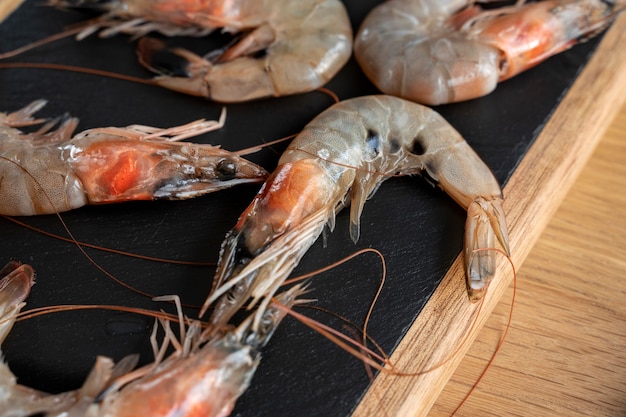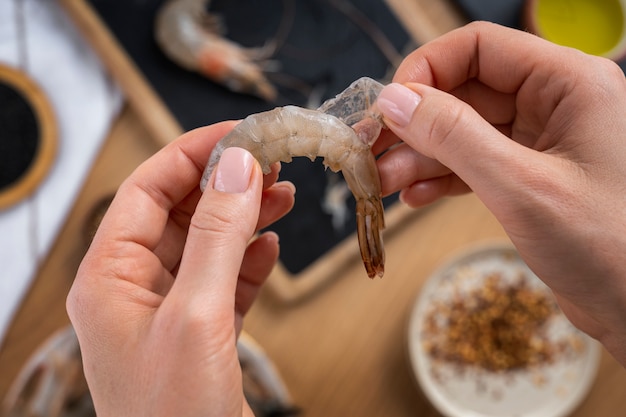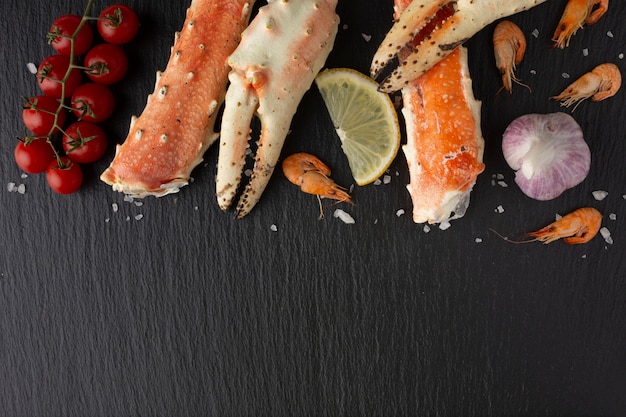Let's be honest, frozen lobster can be a bit of a culinary wildcard. Some folks swear by it, claiming it's a delicious and convenient shortcut to a fancy meal. Others, well, they're not so sure. Personally, I'm firmly in the "it's a decent option" camp. I've had some truly delightful frozen lobster dishes in my time, and it definitely beats the hassle of tracking down a live one (believe me, I've been there, and it's an experience!).
But here's the thing: cooking frozen lobster isn't quite the same as tackling a fresh one. It has its own quirks, and you need to know a few tricks to avoid ending up with rubbery, disappointing results. That's where this guide comes in. I'm going to break down everything you need to know, from selecting the right lobster to achieving that perfect juicy, tender texture. Let's dive in!
(Part 1) Choosing Your Frozen Lobster: The Foundation of a Great Meal

Just like picking a fresh lobster, choosing the right frozen option is crucial to setting yourself up for success. Frozen lobsters come in a range of forms, each with its own advantages and disadvantages. Let's take a look at the main contenders:
1. Whole Lobsters: The Classic Choice
A whole frozen lobster is the ultimate statement piece. You get the full lobster experience, with the head, tail, and claws all intact. It's perfect for those who love a bit of a culinary challenge (and don't mind a little mess) because you'll need to crack it open to get to the delicious meat inside. A whole lobster is ideal for making a real show of things, perhaps with a celebratory feast for a small gathering.
2. lobster tails: The Convenient Option
Lobster tails are hands-down the most popular choice for frozen lobster. They're relatively easy to cook, with the meat conveniently concentrated in the tail section. Lobster tails are perfect for smaller meals or even for just a couple of people. They're also great for grilling or baking, adding a nice smoky flavour.
3. Lobster Claws: The Meaty Delights
Lobster claws offer a happy compromise. They're loaded with juicy, meaty goodness and are a fantastic alternative to whole lobsters if you're looking for something a bit more manageable. Claws are excellent for dipping or adding to a pasta dish. Plus, you get that fantastic cracking and picking experience!
4. Frozen Lobster Meat: The Time-Saving Solution
Frozen lobster meat is the ultimate convenience option. It's already cooked and comes in chunks or flakes, making it perfect for whipping up quick and easy dishes like stir-fries, salads, or even just topping a baked potato. You don't need to worry about thawing and cooking, which is a big plus if you're short on time.
(Part 2) Thawing Frozen Lobster: A Gentle Process

So, you've chosen your lobster. Now it's time to defrost it. This is where a lot of people get a bit nervous, fearing they might ruin their precious crustacean. But fear not! With the right approach, thawing frozen lobster is a simple process.
1. The Fridge Method: Slow and Steady Wins the Race
If you're looking for the best possible texture and flavour, the refrigerator method is the way to go. It's the slow and gentle method, allowing the lobster to thaw gradually and evenly. Place your lobster in a container, cover it tightly, and leave it in the refrigerator for about 24 hours. The slow thawing ensures that the meat doesn't get tough or lose its moisture.
2. The Cold Water Method: A Quick Fix
Sometimes, we just don't have 24 hours to spare. In that case, the cold water method can come to the rescue. This method is faster but not quite as gentle on the lobster. Submerge your lobster in a bowl of cold water, making sure the water completely covers it. Change the water every 30 minutes to keep it cold and prevent the lobster from warming up too much. This method will take about 30 to 60 minutes.
3. What NOT to Do: Thawing at Room Temperature
This is a big no-no! Thawing at room temperature can lead to bacteria growth, making your lobster unsafe to eat. Always stick with either the fridge or cold water method for safe and tasty results.
(Part 3) Cooking Frozen Lobster: A Variety of Options

Now comes the fun part - cooking your lobster! There are a variety of methods, each offering a unique flavour and texture. Let's explore the most popular ones:
1. Boiling: The Classic Technique
Boiling is the classic way to cook lobster, and it's perfect for whole lobsters. Fill a large pot with water, add a generous amount of salt, and bring it to a rolling boil. Carefully lower the lobster into the boiling water, making sure the water completely covers it. Cook for about 10-12 minutes per pound, or until the flesh is opaque and firm.
2. Steaming: A Healthier Approach
Steaming is a healthier alternative to boiling and can help retain the lobster's natural moisture, resulting in a tender and juicy texture. Place the lobster in a steamer basket and add water to the bottom of the pot. Bring the water to a boil and then steam the lobster for about 10-12 minutes per pound.
3. Grilling: A Smoky Delight
Grilling adds a delicious smoky flavour to your lobster. Preheat your grill to medium-high heat. Place the lobster on the grill and cook for about 6-8 minutes per side, or until the flesh is opaque and firm. Grilling is a great option for lobster tails or individual claws.
4. Baking: Convenience and Flexibility
Baking is a convenient method that allows you to add spices and herbs to your lobster. Preheat your oven to 400°F (200°C). Place the lobster in a baking dish and bake for about 15-20 minutes, or until the flesh is opaque and firm. Baking is a good choice for whole lobsters or individual claws.
5. Pan-Frying: For a Crispy Crust
Pan-frying is a fantastic way to achieve a beautiful, crispy crust on your lobster. Heat some oil in a pan over medium-high heat. Add the lobster to the pan and cook for about 4-5 minutes per side, or until the flesh is opaque and firm. Pan-frying works well with lobster tails or individual claws.
(Part 4) Mastering the Art of Doneness: Knowing When Your Lobster is Ready
There's nothing worse than overcooked lobster. It becomes tough, rubbery, and loses its delicate flavour. That's why it's essential to know how to tell when your lobster is perfectly cooked.
1. The Colour Test: A Visual Cue
The colour of the lobster flesh is a great indicator of doneness.
- Raw: The flesh will be translucent and pale.
- Cooked: The flesh will be opaque and a firm, white colour.
2. The Skewer Test: A Reliable Method
Another reliable way to check for doneness is to insert a skewer or toothpick into the thickest part of the lobster. If the skewer comes out hot and the meat feels firm to the touch, it's cooked through.
(Part 5) Essential Tips for Cooking Frozen Lobster: Avoiding Common Mistakes
Here are a few valuable tips to help you avoid any culinary mishaps and ensure you end up with a delicious lobster feast.
1. Don't Overcook: The Key to Tender Lobster
Overcooking is the biggest enemy of tender lobster meat. Follow the cooking time guidelines closely, and check for doneness using the colour and skewer tests.
2. Seasoning is King: Adding Flavor to Your Lobster
Don't be shy with the seasonings! A little salt and pepper go a long way, but feel free to get creative with other flavourings. Garlic powder, paprika, herbs like parsley, thyme, and dill, or even a dash of cayenne pepper can all add delicious dimensions to your lobster.
3. Lobster and Sides: Complementary Companions
Lobster pairs beautifully with a variety of side dishes, creating a well-rounded and satisfying meal. Think creamy mashed potatoes, sautéed asparagus, a refreshing salad, or even a simple bed of rice. Choose sides that complement the lobster's flavour and texture.
4. Cracking and Enjoying: The Final Act
Once your lobster is cooked, it's time for the satisfying ritual of cracking it open and enjoying the delicious bounty inside. You can use a lobster cracker, a kitchen knife, or even a good old-fashioned mallet. Just be sure to get a good grip and enjoy the cracking process!
(Part 6) Storing Leftover Lobster: Preserving the Goodness
You've cooked your lobster, feasted like royalty, and now you have leftovers. Not to worry! Frozen lobster can be stored and enjoyed later.
1. Refrigerator Storage: A Short-Term Solution
Store leftover lobster in an airtight container in the refrigerator. It will last for about 3-4 days.
2. Reheating Leftovers: Gentle is the Key
You can reheat your lobster in the microwave, oven, or on the stovetop. Just make sure to heat it gently to avoid drying out the meat.
3. Freezing Leftovers: Long-Term Storage
You can also freeze cooked lobster for later use. Store it in an airtight container in the freezer for up to 3 months.
(Part 7) Frozen lobster recipes: Inspiration for Your Next culinary adventure
Looking for some delicious ways to use your frozen lobster? Here are a few of my favourite recipes, perfect for both casual meals and special occasions.
1. lobster mac and cheese: A Classic with a Twist
Lobster mac and cheese is a classic comfort food, elevated with the addition of succulent lobster meat. Use frozen lobster tails or pre-cooked lobster meat, and add it to your favourite mac and cheese recipe for a truly decadent treat.
2. lobster bisque: A Creamy and Comforting Soup
Lobster bisque is a rich and creamy soup that's perfect for a cold winter day. It's easy to make with frozen lobster meat and a few simple ingredients like cream, onions, and seasonings.
3. Lobster Salad: A Light and Refreshing Option
Lobster salad is a refreshing and light salad perfect for a summer picnic or a casual lunch. Use frozen lobster tails or pre-cooked lobster meat and toss it with your favourite salad ingredients like lettuce, tomatoes, cucumbers, and a light dressing.
4. Lobster Pasta: A Delicious and Easy Dish
Lobster pasta is a delicious and easy pasta dish perfect for a weeknight dinner. Use frozen lobster tails or pre-cooked lobster meat and toss it with your favourite pasta sauce, such as a creamy alfredo sauce or a tangy tomato sauce.
5. lobster roll: A Classic New England Treat
The lobster roll is a classic New England dish that's perfect for a casual lunch or dinner. Use frozen lobster tails or pre-cooked lobster meat and toss it with a simple mayo-based dressing. Serve it on a toasted hot dog bun for a satisfying and flavourful meal.
(Part 8) Frequently Asked Questions (FAQs)
Cooking with frozen lobster can sometimes raise a few questions. Let's address some common ones.
1. Can I Cook Frozen Lobster Without Thawing it First?
While it might be tempting to skip the thawing step, it's not recommended. Cooking frozen lobster without thawing it can result in uneven cooking, with the meat potentially not cooking through. The texture can also be tough and rubbery.
2. Can I Reheat Frozen Lobster?
Yes, you can reheat frozen lobster, but it's best to do so gently to avoid drying out the meat. Reheat it in the microwave, oven, or on the stovetop, using low or medium heat.
3. Can I Freeze Cooked Lobster?
Yes, you can freeze cooked lobster. Store it in an airtight container in the freezer for up to 3 months.
4. How Can I Tell if Frozen Lobster is Bad?
Frozen lobster should be firm and have a mild, fresh smell. If it's soft, mushy, or has a foul odour, it's probably bad and should be discarded.
5. How Can I Tell the Difference Between a Male and Female Lobster?
The easiest way to tell the difference between a male and female lobster is to look at the underside of the tail. Males have a V-shaped notch, while females have a flat, smooth tail.
(Part 9) Conclusion: Unlocking the Delicious Potential of Frozen Lobster
There you have it, your comprehensive guide to cooking with frozen lobster! It's not always a perfect substitute for fresh, but it offers a convenient and delicious alternative when you're looking for a quick and easy meal. With a bit of knowledge and the right techniques, you can elevate your frozen lobster cooking skills to new heights. So go forth, grab your lobster, and enjoy the deliciousness!
Everyone is watching

Prime Rib Roast Cooking Time Chart: Per Pound Guide
Cooking TipsPrime rib roast. Just the name conjures images of lavish dinners, crackling fires, and hearty laughter. It’s ...

How Long to Bake Potatoes in the Oven (Perfect Every Time)
Cooking TipsBaked potatoes are a staple in my kitchen. They're incredibly versatile, delicious, and surprisingly easy to m...

Perfect Rice Every Time: The Ultimate Guide to Cooking Rice
Cooking TipsAs a self-proclaimed foodie, I've always been a bit obsessed with rice. It's the foundation of countless cuisi...

The Ultimate Guide to Cooking Asparagus: Tips, Techniques, and Recipes
Cooking TipsAsparagus. The mere mention of this spring delicacy conjures up images of vibrant green spears, crisp and burs...

Ultimate Guide to Cooking the Perfect Thanksgiving Turkey
Cooking TipsThanksgiving. Just the word conjures up images of overflowing tables laden with delicious food, the scent of r...
